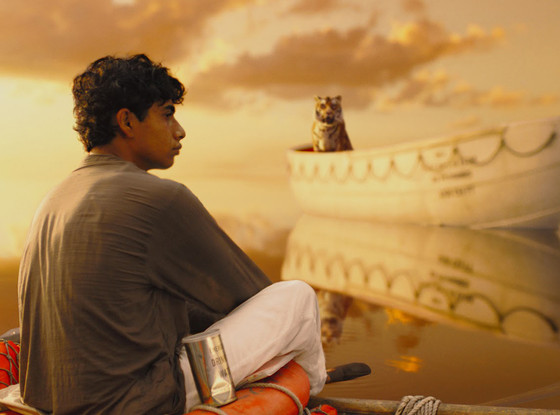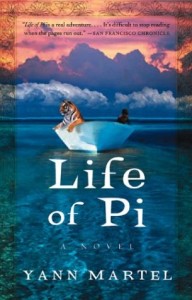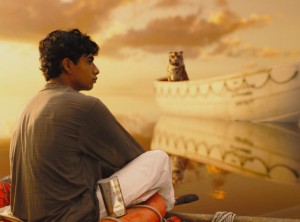I’d imagine the toughest feat for a writer would be that of adapting a novel into a screenplay. The two are such distinctly different animals in development, and yet in execution both must convey the same essence. In writing a screenplay based on a book, you are writing for two different kinds of audiences – those who have read the book and those who have never read the book – and to top it all off, the heart of the story must be captured in a very short amount of time.
I’ve seen a lot of books made into movies but none pulled off as almost-flawlessly (we’ll get to the “almost” part in a bit) as Life of Pi. Based on the amazing novel by Yann Martel, Ang Lee’s film (screenplay by David Magee) retells Pi’s story not only in visually stunning fashion but with the same witty candor and heartbreak as the original. But what makes the film an instant standout among adaptations is not its stunning visuals or its excellent script but its ability to tell the same story without sacrificing what makes it both a superb novel and a superb film.
Too many movies have made the mistake of falling into the category of a visual book. Having learned how to do both, I know that writing a screenplay and writing a novel is as different as night and day. A novel’s strengths could be a film’s biggest weakness, and what makes a killer movie makes no difference in how a book will stick with you even years after you’ve read it. Then again, film adaptations always run the risk of lacking the substance that made the original story such a winner in the first place – to the point where you’re thinking, Hey, where’d my book go?
So why exactly does Pi pull off this feat so flawlessly? Let’s take a look.
The structure of the story remains the same.
Fans of books made into movies are usually preoccupied with the details when it comes to critiquing the film. I was like this with the Harry Potter movies when I was younger, especially when The Sorcerer’s Stone came out and I was all butt-hurt that my favorite line in the book didn’t really make it fully into the movie. But what really matters in film adaptations is not the details, it’s the essential structure of the story.
Life of Pi the novel was written in three parts – Part 1 exploring Pi’s background that lays the foundation for the story (hey, it isn’t called Life of Pi for nothing) – leaving Part 2 to relay the unfolding action for the story between Pi and Richard Parker – and Part 3 to conclude with the ending of the story as Pi washes up on shore. Life of Pi the movie followed the very same structure, right down to the Japanese men interviewing Pi at the end. The movie could just as easily have chopped out the first part and cut straight to the action and embellished – disappointing fans of the book – or it could have decided to get clever and put the Japanese men interviewing Pi at the beginning, instead putting the entire movie into “flashback mode” – disappointing movie-goers. But it didn’t. If a screenplay is faithful to the original structure of the novel, then the right details that are crucial to telling the story as a script, and as a movie, will fall into place (assuming, of course, you also have the best screenwriter for the project!).
The strongest elements are highlighted.
Reflecting on Life of Pi the novel and Life of Pi the movie were ultimately the same experience for me, and you can’t often say that about a book made into a movie. The origin of Pi’s name – and Richard Parker’s, the name of the ship (Tsimtsum), Pi weeping over killing a fish for food, Pi’s “survival guide” narration, Pi commenting on Richard Parker unceremoniously abandoning him…. All those seemingly little moments are what give the story its heart and soul, and the movie included all of those essential moments without feeling like it was uncomfortably crammed into two whole hours.
The right moments are visually stunning.
Okay, so I’ve said Life of Pi is visually stunning – but take into account it matters what is visually stunning, and Pi the movie gets the right what. A novel relies solely on the imagery the reader is able to conjure in their mind, but a lot more is at stake with a movie and even more so with a movie based on a book. The film not only has to be visually appealing for a film’s expectations, now it must be visually appealing on a level predetermined by the expectations of those who have read the book.
It can be a tough act to follow, and Life of Pi the movie follows beautifully in Life of Pi the novel’s footsteps. Before seeing the movie, I read that Life of Pi was director, Ang Lee’s first film incorporating 3D – and I have a huge beef with 3D special effects, they have to be done a certain way for me to warm up to them – and I have to say the balance was perfect. Effects are sometimes overdone to the point of the movie feeling unrealistic, and this was definitely not the case with Pi. Just like the book, it felt both fantastical and real – and from the fierce storm on the ship to the simplicity of shooting in India, the right moments for this story to be visually stunning as a film could not have been chosen more perfectly.
I didn’t even mention how incredible the casting was for young Pi. Gotta give it to Suraj Sharma for his dedication to the role, he gave one heck of a performance.
Okay, so why do I give Life of Pi the movie an “almost-flawless” rating? I do have a couple complaints with the film version, and I want to dissect not only why I have the complaints (what I feel went wrong) but why I believe writer, David Magee and director, Ang Lee made the choices they did in writing and executing the screenplay.
a) In the forward to Life of Pi the novel, author Yann Martel talks about how he came to hear the story in the first place – from the real Pi himself, while Martel was visiting India to write for a different novel set in Portugal. (This was also included as a separate narration in the actual book, scattered across various chapters throughout Pi’s story.) This same scenario is presented in Life of Pi the movie as well, with Rafe Spall playing the writer who comes to adult Pi to hear his miraculous story. But while for the book it did a wonderful job of acting as a set-up for, and accompaniment to Pi’s story, somehow in using it as a device in the film, it falls flat. Automatically the ending is given away, since we obviously know Pi survives his ordeal – which served the novel just fine, but a film with that intense of a storyline needs that suspense to really make it good. Do I think the film would have been better off without incorporating the writer (based on Yann Martel himself) coming to talk to adult Pi? Not necessarily. Those scenes spliced between the telling of Pi’s story served as a nice breather from the action, and like I mentioned earlier, it instilled a lot of that same heart that’s present in the book.
b) In the novel, the alternate, more “believable” story Pi offers up to the Japanese men that interview him in the end is just heartbreaking. It’s communicated mostly through dialogue, which again, worked for the book so I can see why it would be translated that way into the film version as well. But for the film, I would have liked to see the idea shown in a visual way, rather than just Pi fabricating this story solely through dialogue from a hospital bed. The scene just loses something and definitely fell short of my expectations. Even if just shown as a short, narrated scene, I feel something more like that would have made for a more powerful ending for the film.
I would guess that both of these choices were made for mostly creative reasons, and I applaud David Magee and Ang Lee for being as faithful to the book as possible. But unfortunately I feel the movie ended up lacking a bit because of them.
What did you think about Life of Pi the movie – as either a reader of the original book or as just a movie-goer – and what would you say makes a dynamite film adaptation?
Image credits:
Film: Twentieth Century Fox Film
Book: The Blist


